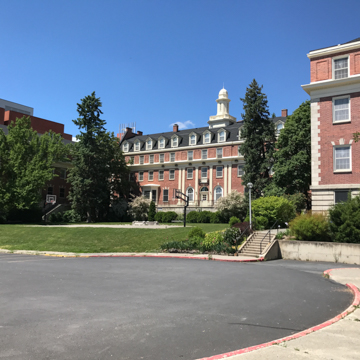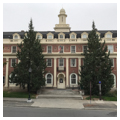You are here
Stimson Hall
Stimson Hall men’s dormitory, its main entrance facing onto College Avenue on the southern edge of the campus core, is perhaps the most finely detailed of the early residential halls at Washington State University. Known initially as the “new dorm,” it was renamed in 1924 after Fred S. Stimson, a regent of Washington State College. Upon announcement of its renaming, the college newspaper referred to Stimson as the “best building on campus” and pointed out that the construction of the building “has been looked upon as the turning point in the advance of the college.” The $150,000 Georgian Revival dormitory originally housed 257 students.
Designed by Rudolph Weaver, Stimson Hall is the oldest surviving men’s dormitory on campus and its most definitive representative of the Georgian Revival. Several Georgian Revival designs, mostly for residential halls, proliferated on campus in the early twentieth century under the architectural direction of Weaver and, later, Stanley Smith; their designs recalling buildings that had long characterized established East Coast institutions of the colonial period such as the College of William and Mary and Harvard University. Whether undergraduates would have been familiar with the architectural traditions or universities from which these halls sprung is unknown; it is likely, however, that the architects and administrators at Washington State College found them appropriate as models for distinguished settings for undergraduate life.
Stimson Hall is a symmetrical, U-shaped, three-story building, distinguished by its thirteen dormers with fanlights and its passageways with cross vaults and brick ribs through its west and east wings. The main, north facade also includes two-story terra-cotta Doric pilasters framing doorways and windows, as well as cartouches, tracery windows, and quoins. The south facade, which is similar to the north save for wings that extend the plan into a modified U-shape, features two large bay windows on either side of the center. Today, the south facade opens to a patio and basketball court, and for many years included a fountain, built by students, called Minerva (vandalized in 2008 and removed for restoration). Like much else in the campus core, red brick is the dominant exterior material for Stimson Hall, but the pilasters and window trim are of terra-cotta. A cupola crowns the building.
Grace Jones, an interior designer based in Spokane, provided the design for the elegant, wood-paneled lobby with its built-ins, wooden beams, and library. The interior of the building has undergone upgrades over the years, including a $4 million rehabilitation in 1986. Yet its function as a dormitory, even during World War II when it was turned over to the military, has never changed. Stimson Hall still features its own form of student governance, and for several years only upperclassmen were permitted to reside on the top floor.
While many early structures connected the growing college with the town of Pullman somewhat literally through a west-facing orientation, Stimson Hall connected primarily through its “self-amortization” funding model. To provide housing for a growing student population in the 1920s and 1930s, community members bought shares in a corporation that sold bonds for construction of several residential halls. Stimson Hall was one of several new residential halls to be constructed under this model.
Writing Credits
If SAH Archipedia has been useful to you, please consider supporting it.
SAH Archipedia tells the story of the United States through its buildings, landscapes, and cities. This freely available resource empowers the public with authoritative knowledge that deepens their understanding and appreciation of the built environment. But the Society of Architectural Historians, which created SAH Archipedia with University of Virginia Press, needs your support to maintain the high-caliber research, writing, photography, cartography, editing, design, and programming that make SAH Archipedia a trusted online resource available to all who value the history of place, heritage tourism, and learning.





















